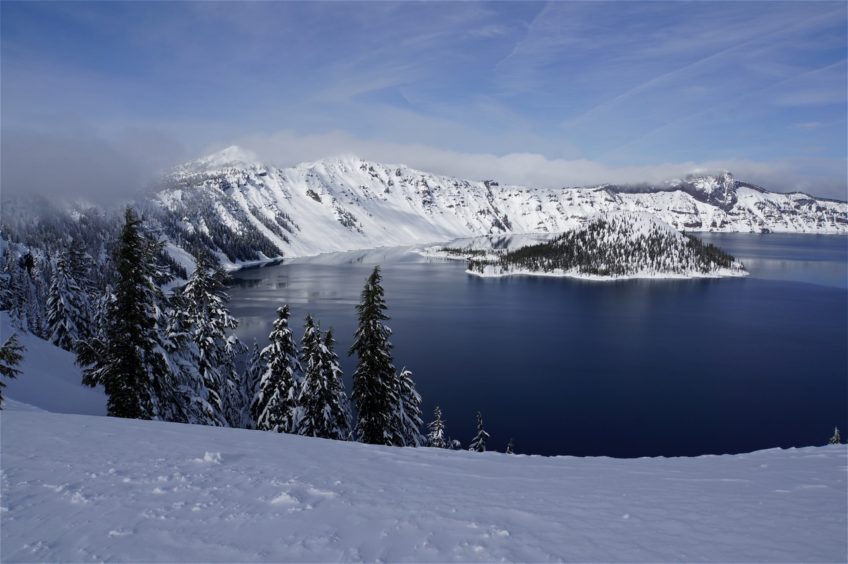After my royal treatment in Portland, I was somewhat hesitant, yet simultaneously excited to return to the road. I couldn’t help the excitement that crept over me when I imagined my next big stop: Crater Lake. This National Park has always captivated me, but I have never been there before! The road to Crater Lake, however, was long and full of excitement. As I drove, I kept my fingers crossed, hoping for good weather when I arrived.
The road from Portland to Bend, OR meandered through alpine forests, dove into valleys, and crested high ridges. I transitioned from dry roads, to snow, to dry again, and returned to snow. Eventually, I emerged onto a painfully straight road that cut across the high flat plain of the Warm Springs Reservation. I had effectively left the dense forests and high altitude cloud cover behind, transitioning abruptly into a sparse desert landscape grazed by cattle and horses. As my road transitioned to a more southerly trajectory, I crossed through the Peter Skene Ogden Scenic Viewpoint and tempted catastrophe dangling my feet over the high canyon bridges.



Just before I hit Bend, I recognized one of the seven wonders of Oregon rising out of the plain to the east. Smith Rock juts from the landscape like a volcanic spine, providing stunning views, epic rock climbing, and an otherworldly elevation among Oregon’s eastern flatlands. With the weather trending between mist and total downpour, I chose not to explore the ridge more closely, knowing that I should return when the weather permitted climbing and views unimpeded by low hanging clouds. My short exploration validated the rock’s status as one of Oregon’s best kept treasures. Its sheer walls and sharply crenelated ridgeline feel completely foreign, yet simultaneously inviting. Dear Smith Rock, we will meet again!

As I coasted through Bend, I decided to move onwards in the direction of Klamath Falls. Although I definitely don’t regret that decision, I unwittingly drove into a stressful winter storm on one of the worst roads I have driven thus far. Highway 97 unimpeded southern route slices through National Forests, State Forests, Wildlife Refuges, and countless other protected areas. The views (while they lasted) were stunning, but the road was incredibly lonely. As the sun dropped behind the trees, the misting rain transitioned to quarter-sized snowflakes, coating the road in a slick, unstable white sheen. I slowed accordingly, but then my headlights illuminated an ominous sign: “Severe Potholes. Next 17 miles.” Unsure of what the state of Oregon considered a “Severe Pothole,” I drove on curiously. Within a few miles, I slowed my speed to a crawl, dodging bovine-sized craters that would have been more at home on the moon. Paired with the slippery coating of fresh snow, this proved a very dangerous combination. Despite my snail-like pace, I still lost grip on the road a few times, quickly correcting the slide while simultaneously attempting to avoid being eaten by the gaping holes in the road. Every now and then, an eighteen-wheeler would scream past, clearly unperturbed by the missing chunks of roadway. Two hours later, I rolled into Klamath Falls mentally and physically exhausted, but alive.
Waking early, I headed straight for a local coffee shop where I met an elderly man named Butch, another veteran now living in Klamath Falls. For the better part of an hour, we walked through my route and he shared stories from his own travels across the country. His tales of motorcycling and RV camping through the West, sleeping in cemeteries, and sharing his love of wilderness with his children only increased my excitement to rush towards my destination for the day: Crater Lake.

After giving Butch the full tour of Sam, I returned to the road. As I retraced my steps northwards, my gaze frequently drifted towards the sky, questioning whether the summit of Crater Lake would be clear or enveloped by misty grey. Near Chiloquin, I hopped onto Route 62, leaving behind the pockmarked Highway 97 for good. 62 started its ascent just north of Klamath Lake, beginning in flat, snowy plains before climbing steadily through larger and larger snowdrifts into dense old growth forests. As the drifts grew taller, my speed gradually slowed. Upon entering the park, I began to drive through a bright tunnel with snow banks towering on either side. I shared the road with the occasional snowplow, but was largely alone as I wound through the forest towards Crater Lake. When I pulled into the visitor’s center parking lot, I could barely make out the outline of roofs and second story barely visible above the twenty-foot drifts.

As I killed the engine ready to check-in with the ranger, I saw blue sky. I immediately restarted the engine and kicked the car back into gear, rushing towards the summit. Five minutes later I clambered up a towering wall of snow and beheld the sun defiantly shining down on Crater Lake. The clouds had evaporated away to a fine mist lingering in the periphery of my vision. With most of the roads hiding under metric tons of snow, I hauled out my snowshoes and began tromping along the high ridge encircling the lake. Soon, I stood alone in a whitewashed landscape of snow-plastered trees, staring down at the deep blue of Crater Lake.



Of course I had heard tales about the captivating waters of Crater Lake, but it really does take your breath away. Having grown up on Lake Superior, I am relatively familiar with the depth of color that clean water can hold, but Crater Lake blows Lake Superior away. This is, in part, due to its unique creation story.


Crater Lake began as a roughly 12,000 foot peak: Mount Mazama. Part of the volcanic Cascade Range, Mount Mazama had been growing steadily for hundreds of thousands of years. As the mountain grew, the magma chamber welling beneath it also grew, creating an infrastructure of unsteady molten rock. About 7,700 years ago, Mazama’s crust could no longer contain the pressure brewing inside. Fissures sliced through the crust, spewing pumice and ash before releasing lava flows that slowly drained the subterranean chamber. As that chamber emptied, Mazama violently exploded with 42 times the force of the 1980 St. Helens eruption, sending a cloud of volcanic dust 5-10 miles into the atmosphere moving at twice the speed of sound. This event also triggered the mountain’s collapse and the creation of the caldera that would become Crater Lake.

Crater Lake serves as an impressive monument to Mount Mazama’s fiery past. The deep vacuum left behind by the evacuated magma allows for Crater Lake’s almost mystical depth. With a maximum depth of 1,949 feet, Crater Lake is the deepest lake in the United States and ranks among the top ten deepest in the world. If the volcanism of the landscape wasn’t already apparent, a massive cinder cone named “Wizard Island” rises dramatically 755 feet above the surface of Crater Lake. Rising from the lake bottom, Wizard Island, like an iceberg, leaves much to the imagination.

Yet it is not the depth of the lake or the height of the submarine cinder cone that captivates, it is the water. There are no headwaters that lead into this caldera. All of the water contained within Crater Lake comes from the sky and only leaves via evaporation. With epic winter snowfall and precipitation from September to May, the lake maintains a relatively steady depth. The clarity and purity of the lake also benefit from its unique mountaintop location. Crater Lake has some of the purest water in the world. I have often lauded the purity and water clarity of Lake Superior, whose average clarity is about 25 feet. For a lake of its size, that is exceptional. Crater Lake, on the other hand, has an average clarity of around 100 feet, with a record clarity of almost 150 feet. Whoa. These water conditions are what give the water its epic blue color, something that must be to experienced to be properly understood. It is an amazing body of water.

After snowshoeing around the crater’s rim for a few hours, I returned to the ranger station to stamp by passport and watch the park’s film. After that, I returned to the road, following the gushing Rogue and Umpqua Rivers toward the coast. Crater Lake may not have any tributaries or inlets, but the 533 inches of annual snowfall that doesn’t land in the crater or on its rim melt into these roaring rivers, eventually coursing towards the Pacific. My road kept pace with the water, wandering past the imposing Mount Thielsen and into the rugged gorge of the Umpqua River, until I finally crash-landed in the Umpqua National Forest. Tomorrow, I would return to the coast and would begin tracing the route of my 2013 bike trip.


Just another day on the road



One Response
Jean Cronon
Too bad that you had to deal with all that snow, but it IS winter with hazardous hiking. At least the water in the crater isn’t frozen so you could get the view of the very blue water. Getting close to the edges of the lake with those conditions must have been scary, but you seem to be immune to fear.